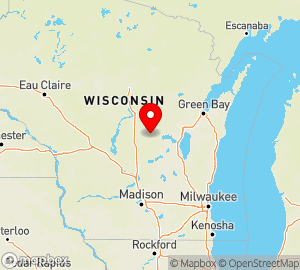Wisconsin
Wisconsin State Information

www.wisconsin.gov
Area (sq mi):: 65497.82 (land 54310.10; water 11187.72) Population per square mile: 101.90
Population 2005: 5,536,201 State rank: 0 Population change: 2000-20005 3.20%; 1990-2000 9.60% Population 2000: 5,363,675 (White 87.30%; Black or African American 5.70%; Hispanic or Latino 3.60%; Asian 1.70%; Other 3.70%). Foreign born: 3.60%. Median age: 36.00
Income 2000: per capita $21,271; median household $43,791; Population below poverty level: 8.70% Personal per capita income (2000-2003): $28,570-$30,685
Unemployment (2004): 5.00% Unemployment change (from 2000): 1.60% Median travel time to work: 20.80 minutes Working outside county of residence: 26.10%
List of Wisconsin counties:
Wisconsin Parks
- US National Parks
- Urban Parks
- State Parks
- Parks and Conservation-Related Organizations - US
- National Wildlife Refuges
- National Trails
- National Scenic Byways
- National Forests
Wisconsin
[wi′skän·sən]Wisconsin
Thirtieth state; admitted on May 29, 1848
State capital: Madison Nicknames: Badger State; America’s Dairyland; Copper
State State motto: Forward State animal: Badger (Taxidea taxus); wildlife animal:
White-tailed deer (Odocoileus virginianus) domestic ani
mal: Dairy cow (Bos taurus)
State ballad: “Oh Wisconsin, Land of My Dreams”
State beverage: Milk
State bird: Robin (Turdus migratorius)
State dance: Polka
State dog: American water spaniel
State fish: Muskellunge (muskie, Esox masquinongy
Mitchell)
State flower: Wood violet (Viola papilionacea)
State fossil: Trilobite (Calymene celebra)
State fruit: Cranberry (vaccinium macrocarpon)
State grain: Corn (Zea mays)
State insect: Honeybee (Apis mellifera)
State mineral: Galena
State rock: Red granite
State soil: Antigo silt loam
State song: “On, Wisconsin!”
State symbol of peace: Mourning dove (Zenaidura macroura
corolinensis linnaus)
State tree: Sugar maple (Acer saccharum)
State waltz: “The Wisconsin Waltz”
More about state symbols at:
www.wisconsin.gov/state/core/wisconsin_state
_symbols.html
dnr.wi.gov/org/caer/ce/eek/nature/state/index.htm
More about the state at:
www.wisconsinhistory.org/
SOURCES:
AmerBkDays-2000, p. 400
AnnivHol-2000, p. 89
STATE OFFICES:
State web site:
www.wisconsin.gov
Office of the Governor
State Capitol
PO Box 7863
Madison, WI 53707
608-266-1212
fax: 608-267-8983
www.wisgov.state.wi.us
Secretary of State PO Box 7848 Madison, WI 53707 608-266-8888 fax: 608-266-3159 www.sos.state.wi.us
Wisconsin Dept of Public Instruction Library Services Div 125 S Webster St PO Box 7841 Madison, WI 53707 608-266-3390 fax: 608-267-1052 www.dpi.state.wi.us/
Legal Holidays:
| Christmas Eve | Dec 24 |
Wisconsin
a state in the northern United States. Area, 145,400 km2. Population, 4.4 million (1970), 64 percent of which is urban (1960). Its capital is Madison, and its largest city is Milwaukee. Wisconsin occupies a plain between Lakes Michigan and Superior. In the north the soil is podzol; in the south it is brown forest soil. Coniferous and broad-leaved forests cover 42 percent of the state, and there is much meadowland and arable land.
Wisconsin is an industrial agricultural state. Processing industries employ 510,000 people (1968); about 3,000 are employed in mining. Zinc ore is mined on a small scale. Electropower plants produce 5.3 million kV (1968). The most highly developed processing industries are metalworking and machine building (manufacture of agricultural and road-building machinery, tractors, boilers, turbines, and motors). The paper, furniture, woodworking, and food industries are also important. Animal husbandry, especially dairy animals, accounts for about two-thirds of the state’s commercial agricultural production.
Wisconsin is one of the United States’ major producers of cheese and butter and supplies much fresh milk to the country. There are 4.1 million head of cattle, including 2.1 million milch cows (1968). The main crops are fodder grasses, wheat, barley, and silage corn. The state also has horticulture and market gardening. Ship traffic on the Great Lakes is also important.
V. M. GOKHMAN
The first settlement of Europeans in what is today Wisconsin was founded in 1634 by Frenchmen. In 1763, Wisconsin was taken over by Great Britain, and in 1783 it became part of the United States, but until 1816 it remained independent from the British trading company in the area. In 1848 the territory of Wisconsin became a state.